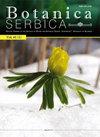Ruderal vegetation in Serbia - diversity and floristic composition
IF 0.9
4区 生物学
Q4 PLANT SCIENCES
引用次数: 1
Abstract
This study represents the first data gathering and analysis of the floristic composition of ruderal vegetation in Serbia, published over the last 70 years. The dataset included 748 relev?s of ruderal communities and a total of 716 plant species and subspecies. The study showed that the most abundant were widespread taxa, especially taxa of the Eurasian area type, while alien species accounted for a relatively small proportion of the ruderal flora (about 10%). Therophytes and hemicryptophytes were most abundant in the life form spectra. Five vegetation groups were identified, corresponding to the following vegetation classes: Bidentetea, Sisymbrietea, Digitario sanguinalis-Eragrostietea minoris, Artemisietea vulgaris and Polygono-Poetea annuae. The analysis of similarity showed that there are small floristic differences between particular vegetation groups. The determined diagnostic species for the vegetation groups were compared with those of the corresponding anthropogenic vegetation classes, and a high degree of similarity was found for all but one group. The most frequent taxa in all five groups were Polygonum aviculare, Convolvulus arvensis, Plantago major subsp. major and Chenopodium album.塞尔维亚的原始植被。多样性和区系组成
这项研究是近70年来首次对塞尔维亚原始植被区系组成进行数据收集和分析。该数据集包括748条相关信息。野外群落中有716个植物种和亚种。研究表明,广布的类群最为丰富,以欧亚地区型类群最为突出,外来物种在原始区系中所占比例相对较小(约为10%)。在生命形式光谱中,热生植物和半隐生植物最为丰富。共鉴定出5个植被类群,分别为Bidentetea、Sisymbrietea、Digitario sanguinalis-Eragrostietea minoris、Artemisietea vulgaris和Polygono-Poetea annuae。相似性分析表明,特定植被类群之间存在较小的区系差异。将各植被类群的诊断种与相应的人为植被类群的诊断种进行比较,发现除1个类群外,其余类群具有高度的相似性。5个类群中最常见的类群分别是蓼、卷花、车前草大亚种。major and Chenopodium专辑。
本文章由计算机程序翻译,如有差异,请以英文原文为准。
求助全文
约1分钟内获得全文
求助全文
来源期刊

Botanica Serbica
Agricultural and Biological Sciences-Plant Science
CiteScore
1.40
自引率
12.50%
发文量
17
审稿时长
34 weeks
期刊介绍:
Botanica Serbica publishes original research papers on all aspects of plant, fungal and microbial biology research including the disciplines of microbiology, mycology, lichenology, bryology, flora, vegetation, biogeography, systematics, taxonomy, plant biotechnology, plant cell biology, plant ecology, environmental plant biology, forestry, genomics, horticulture, limnology, metabolomics, molecular biology, proteomics, virology, plant conservation and protection, and wildlife and ecosystem management.
 求助内容:
求助内容: 应助结果提醒方式:
应助结果提醒方式:


